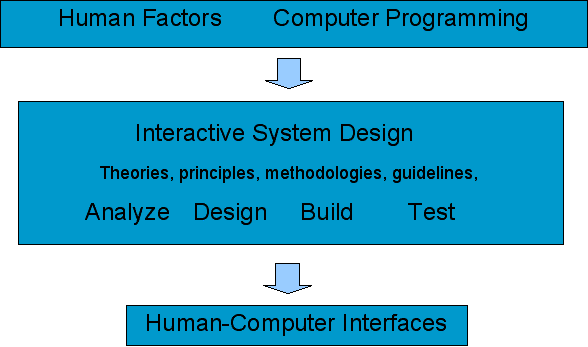


|

|
[ Formal Data | Course Tools | Syllabus & Schedule | Course Books | Course Materials | CourseWeb | Links ]
The goal of this course is to acquaint you with principles and techniques of interactive system design and to help you develop a number of critical scills that will enable you to be employed in the area of user interface design and evaluaton. In particular, we expect every student
Upon satisfactory completion of this course, students will:
Interactive System Design (ISD) is an integral part of Human Computer Interaction (HCI) curriculum. Human Computer Interaction is an important part of Informatics (this is the world often used to cover all science fields related with computers and information processing). HCI is taught at many Computer Science, Information Science and similar departments.
ISD is one of the few core HCI courses that stand on the crossroads of cognitive science courses, computer-programming courses, and advanced system courses. Cognitive science courses such as human information processing or human factors teach you about humans and human side of information systems. System courses teach you about advanced information systems and their technical side. Programming courses give you skills to develop programming artifacts. Core HCI courses bring all that together by teaching you about human-computer interfaces - interactive side of information systems, the side that connects humans with technology.
A course on interactive system design is probably the most important of all core HCI courses. It is supposed to teach how to professionally design and evaluate usable interactive systems. This course has its roots in cognitive science courses and connects to other core HCI courses such as Introduction to HCI or interface development tools.
A graduate degree on human-computer interaction may feature two to four core HCI courses. In this context an ISD course usually concentrates solely on theories, principles, and methodologies of interface design and evaluation. In the context of a broader Information Science degree, ISD is the only core HCI course. In this context, your instructor feels it necessary to extend the traditional content of an ISD course with knowledge that are typically presented in an introductory HCI course (a review of major kinds of interfaces, an introduction to the future generation of HCI). In addition, the instructor will allocate some lecture time to build a bridge between this course, your knowledge of human information processing, and you programming skills.
As you can see from the picture below, the core part of IS2470 course is devoted to the process of design and evaluation of interactive systems, This part will combine teaching fundamental knowledge with teaching some applied skills that will help you in a variety of different careers - from software developer to usability engineer. A smaller part of the course will present a concise overview of human-computer interfaces. The goal of this part is to make you aware about a range of interfaces that can be a target of your design efforts right now and to prepare you to face the new generation of interfaces. The course also provides a brief overview of human information processing issues in the context of interactive system design and a small practical section on developing several kinds of interfaces with Java programming language.

Course assessment includes a number of individual and group assignments and three group projects. Each assignment and project bears certain number of points. The instructor also reserves the right to administer unannounced quizzes for up to 5 points each if he feels that the students are not pursuing a resonable amount of assigned reading. Your final grade depends on the percentage of points you have earned. Score < 50% corresponds to F, 50-62.5 is D range, 65.5-75 is C range, 75-87.5 is B range, and 87.5-100 is A range.
If you have a disability that requires special testing accommodations or other classroom modifications, please, notify both the instructor and Disability Resources and Services by the second week of the term. You may be asked to provide documentation of your disability to determine the appropriateness of accommodations. To notify Disability Resources and Services, call 64807890 (voice or TDD) to schedule and appointment. The office is located in the William Pitt Union, Room 216,
| Tuesday January 6 |
Lecture 1 |
|
| Tuesday January 13 |
Lecture 2 |
Homework 1 due |
| Tuesday January 20 |
Lecture 3 |
Homework 2 due |
| Tuesday January 27 |
Lecture 4 |
USTAD 1st stage due |
| Tuesday February 3 |
Lecture 5 |
Homework 3 due (2 days after L5!) |
| Tuesday February 10 | Lecture 6 USTAD task analysis presentation |
USTAD 2nd stage due |
| Tuesday February 17 |
Lecture 7 |
|
| Tuesday February 24 |
Lecture 8 |
Homework 4 due |
| Tuesday March 2 |
Lecture 9 |
USTAD project due |
| Tuesday March 9 | Spring Break |
|
| Tuesday March 16 | Lecture 10 | First paper summary due |
| Tuesday March 23 | Evaluation project presentation | Evaluation project due |
| Tuesday March 30 | Lecture 11 |
|
| Tuesday April 6 | Lecture 12 | Second paper summary due |
| Tuesday April 13 | Project meetings | |
| Tuesday April 20 | Final project presentations | Final project due |
Copyright © 2004 Peter Brusilovsky